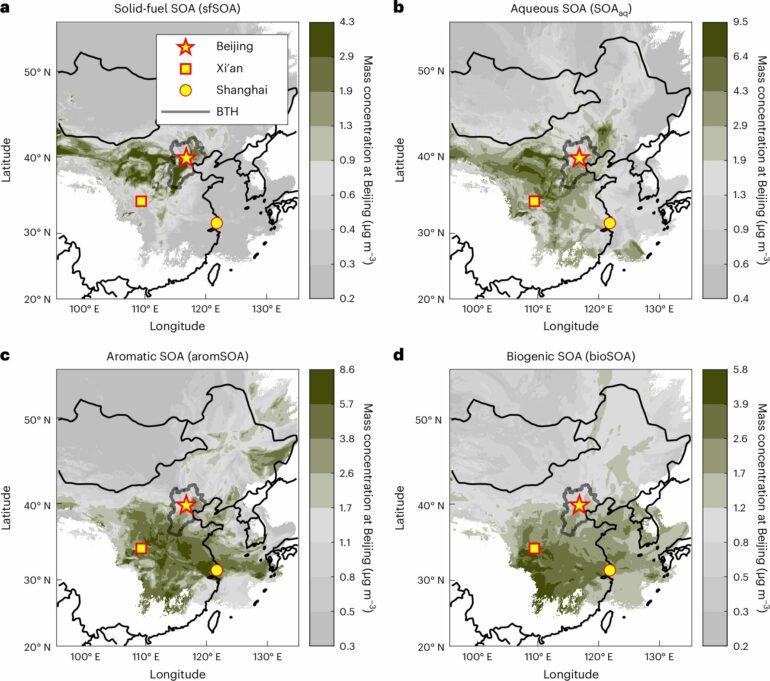An international study led by researchers at the Paul Scherrer Institute PSI has used a new method to identify the various sources of aerosols that create smog in Beijing.
A number of studies have estimated that air pollution is responsible for several million deaths worldwide every year. In order to take appropriate measures to keep the air clean, it is important to know where the pollutants come from. However, pinpointing the exact sources of the pollutants has remained a challenge.
This hurdle has now been overcome by an international team of researchers led by the environmental scientist Kaspar Dällenbach in collaboration with the Beijing University of Chemical Technology and the University of Helsinki. Using a new method, the researchers analyzed the smog over Beijing.
They discovered that the smog that engulfs the metropolitan region is made up of pollutants from sources and regions that vary between the summer and winter months. For their research, they used a new, mobile aerosol mass spectrometer.
“With this new approach, we can analyze smog at a molecular level, enabling a better understanding of its sources and processes in unprecedented detail,” explains Dällenbach. The researchers have published their findings in the journal Nature Geoscience.

Kaspar Dällenbach hopes that his research will contribute to improving air quality worldwide. © Paul Scherrer Institute
A threat to human health
Human health is always at risk when a very large population is exposed to high levels of pollution—as is the case in the vast metropolitan region in eastern China that lies within a radius of some 600 kilometers around Beijing.
The smog in China’s capital is notorious, and Dällenbach views it as a particularly important phenomenon to study given the large population subject to it, in order to expand the database of potential methods for improving air quality.
Although emissions, for example sulfur dioxide from coal burning, have been reduced in the region, a large portion of the country’s population is still exposed to poor air quality. However, it is extremely challenging to determine the origin of the pollutants as their composition is constantly changing through chemical reactions on their long journey through the atmosphere.
This means that the measured signal is blurred, making it difficult to determine the nature of the original molecules and hence the source of the pollution.
Where do the pollutants come from?
To find the sources of the pollution, the researchers measured the air composition on the roof of the Beijing University of Chemical Technology and compared the sources of smog during the summer and the winter months. A new type of mass spectrometer was used, which can analyze the ambient aerosols’ molecular composition in real time.
This molecular information makes it possible to identify the sources of pollution. The scientists distinguish between primary aerosols—i.e., solid and liquid suspended particles that are emitted into the atmosphere—and secondary aerosols, which form as they travel through the atmosphere. The latter are particularly important in Beijing.
Differences between summer and winter
Dällenbach and his colleagues found that the sources of particulate matter extend far beyond the capital city and that these sources differ in chemical and geographical terms between the summer and the winter months.
In winter, the secondary organic aerosols are caused by the combustion of wood and coal and originate, for the main part, in the greater Beijing-Tianjin-Hebei region. In summer, on the other hand, air flows in from the south and pollution is dominated by urban emissions, for example from traffic and industry, probably from the Xi’an-Shanghai-Beijing belt.
“Our work shows that although we are focusing on pollution within Beijing, smog is a large-scale regional phenomenon in which aerosols from different sources are transported over hundreds of kilometers,” explains Dällenbach. Reducing air pollution therefore calls for coordinated and large-scale measures across the entire Beijing metropolitan area and beyond.
Dällenbach and his research group are also using the methods they have developed to understand smog in Europe, as well as in poorly represented urban centers in the Global South.
More information:
Kaspar R. Daellenbach et al, Substantial contribution of transported emissions to organic aerosol in Beijing, Nature Geoscience (2024). DOI: 10.1038/s41561-024-01493-3
Provided by
Paul Scherrer Institute
Citation:
Researchers identify seasonal sources of Beijing smog (2024, August 8)



